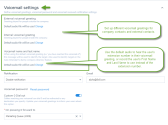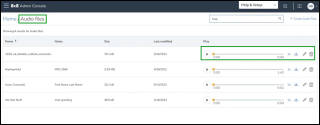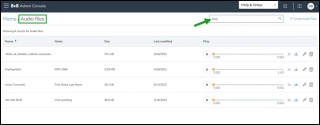Set up voicemail settings
As a phone system administrator, you can define voicemail greetings, and set up voicemail notification and voicemail password for each user. Whether it is an external voicemail greeting, internal voicemail greeting, or general voicemail greeting, you can manage them all from the user's profile:
- External voicemail greeting: Greeting played for people outside the company. In the absence of a custom external voicemail greeting, the default audio greeting is played.
- Internal voicemail greeting: Greeting played for people inside the company. In the absence of a custom internal voicemail greeting, the default audio greeting is played.
- Voicemail name and last name: For general voicemail greeting, you have two options: either choose the default message that includes the user's extension number, or replace the user's extension number with the user's first name and last name in the default message:
- Option 1: General voicemail greeting by default contains the user's extension number, such as: "You have reached the voicemail of [1002]... "
- Option 2: General voicemail greeting contains recorded first name and last name, such as "You have reached the voicemail of [Robin Shasta]..."
Note: Voicemail name and last name greeting is also used for auto attendant's voicemail when accessed through the company directory.
To set up an external voicemail greeting:
- Go to Home > Users.
- While editing a user, open Voicemail settings.
- Go to External voicemail greeting.
- Click Change to open the audio files library. In the absence of a custom greeting, the default audio file will be used.
- Click Save.
When using the default voicemail greeting (i.e. 'you have reached the voicemail of') this message will be used to identify the target. Also used to identify targets in the Auto Attendant's dial by company directory feature.
To set up an voicemail name and last name:
- Go to Home > Users.
- While editing a user, open Voicemail settings.
- Go to Voicemail name and last name.
- Click Change to open the audio files library. In the absence of a custom greeting, the default audio file will be used. By default, the voicemail greeting contains the user's extension number, such as: "You have reached the voicemail of [1002]. " You can record first name and last name, such as "You have reached the voicemail of [Robin Shasta]." For details, see our content on how to manage audio files library.
- Click Save.
To set up an internal voicemail greeting:
- Go to Home > Users.
- While editing a user, open Voicemail settings.
- Go to Internal voicemail greeting.
- Click Change to open the audio files library. In the absence of a custom greeting, the default audio file will be used.
- Upload, record, or select the internal voicemail greeting audio file. For details, see our content on how to manage audio files library.
- Click Save.
Users can receive a voicemail attachment or a voicemail notification via an email when a new voicemail message is left for them. For users without an email address, you can disable the email notification.
To access the voicemail settings:
- Go to Home > Users.
- While editing a user, open Voicemail settings.
- Select the desired Notification.
- Enter an Email address to send the notification to.
- Click Save.
You can allow users to set up their own voicemail access PIN. They receive an email with the instructions to set up their PIN. They need to dial 555 from their device, and enter the number when prompted. For users without an email address, the administrator can set up a voicemail access PIN. The access PIN must have a minimum of six digits.
To reset the voicemail Access PIN:
- Go to Home > Users.
- While editing a user, under Voicemail settings, you can choose to:.
-
Under Voicemail access PIN, you can:
-
Click Users will set their own access PIN to allow users to set up their own voicemail access PIN.
-
Click Set access PIN to set up a voicemail access PIN for users without an email address. The access PIN must be digits only, having a minimum of six and maximum 15 digits, not sequential.
- Enter an Access PIN and retype to confirm.
- Click Save
-
Callers who reach your voicemail can dial zero and be redirected to another destination as defined in your forward option. If this option is enabled for the user, callers can dial 0 anytime during the voicemail message to be forwarded to a contact or service. This option is disabled by default. Update your voicemail greetings to inform your users.
To redirect callers from voicemail by dialing zero:
- Go to Home > Users.
- While editing a user, open Voicemail settings.
- Click to enable Custom 0 Dial out.
- Select a user or service under On pressing 0 forward to to direct your incoming calls. This option appears only after you enable the Custom 0 Dial out option above. Callers who reach your voicemail can dial 0 to be redirected to any destination you specify here. If you have set up a site receptionist for the site, the site receptionist appears by default for custom zero dial out.

Note: According to HIPAA guidelines, it is considered unsafe to send an attachment that can be forwarded. Therefore, administrators should set users to Notification Only. Be sure to lock the setting so that users cannot change this setting from within the 8x8 Work for Desktop.
Manage Audio Files Library
An audio file is a music or message used for voicemail greetings. All audio files are either uploaded or recorded by administrators and deposited in a central location. Audio files can be accessed via 8x8 Admin Console main menu. You can view the list of uploaded audio files, search, play, edit, delete, and download them from a central location.
Notes can be used to add context to your audio files. For example, if you provide your audio file in multiple languages, you can leave a note to indicate the language in which the file is recorded. For easier audio file location, you can sort the list by Name and Notes columns.
To manage audio file repository:
- Log in to 8x8 Admin Console.
- In the main menu, go to Home > Audio Files.
-
Click +Create Audio Files then select one of the following options:
- By uploading an audio file: Upload an existing or pre-recorded audio file from your file directory. Enter a name and a note for the audio file to find it easier in the future. A note can indicate the language of the audio file, for example. Browse and select an audio file from your computer directories, and save.
- By calling a number to record: Record a new audio file just like when you leave a voice message. Provide a name and a note for this new audio file to find it easier in the future. A note can indicate the language of the audio file, for example. Enter your phone number/ extension and save. The system calls your extension or the number you entered and prompts you to record a new audio message.
- Click
 to play the audio file.
to play the audio file. - Click
 to control the playing speed when listening to the music. You can select from 0.5x, 1x, or 2x.
to control the playing speed when listening to the music. You can select from 0.5x, 1x, or 2x. - Click
 to download and save to another location.
to download and save to another location. - Click
 to edit or delete the audio file.
to edit or delete the audio file.
Audio files repository can also be accessed from Users edit page. While editing a user, go to Voicemail settings > Default audio file will be used and click Change. You can also access the audio files from Users > Music-on-hold, Auto Attendant > Call Handling Menus, Call Queues > IVR Message, Call Queues > Voicemail settings, and Ring Groups > Voicemail settings.
Search for specific audio files
You now can narrow a list of selectable audio files by searching them by name (Voicemail, Auto Attendants, Music on Hold, Call Queues etc.), wherever audio files are selectable.
Let’s say you want to look for a specific audio file from a long list of audio files. You now can simply search it by name:
- In the Admin Console Home > Audio Files page, enter the entire name or part of the file name in the Search box. The audio file displays.



